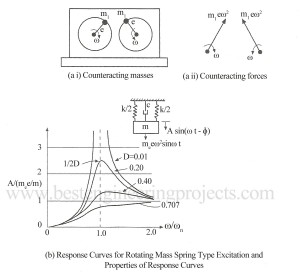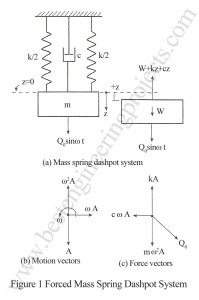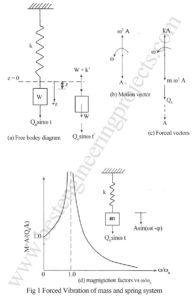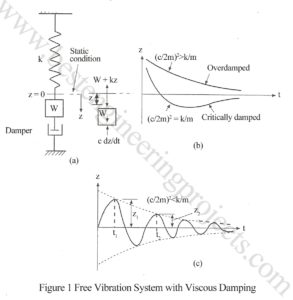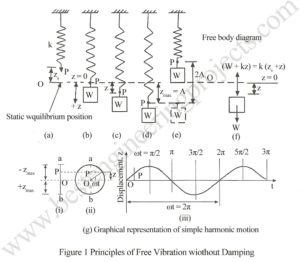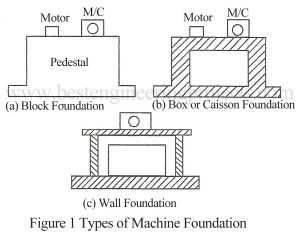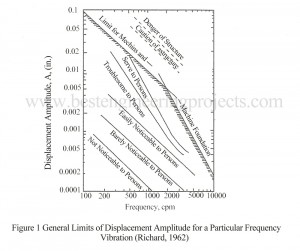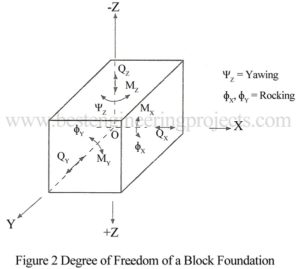There are various methods of analysis for machine foundation. They include: Empirical methods Elastic half space method Lumped parameter method Barkan’s method Among these methods lumped parameter method and barkan’s method are most popular widely used. Empirical methods | Method of Analysis of Machine Foundation The empirical methods suggested by Tschebotarioff and Alpan can be used for preliminary design purpose for the different soil types. However, these methods can be used only to check the occurrence of resonance which in itself is not adequate for a satisfactory design. Elastic Half Space…
Read MoreCategory: Machine Foundation
Forced Frequency Dependent Exciting Force with Viscous Damping
Introduction to Forced Frequency Dependent Exciting Force with Viscous Damping Some machines like Turbo-generators produce unbalanced force which imparts into the foundation-soil system frequency dependent exciting force. In Turbo generators two counteracting masses are placed at an eccentricity, e. This is shown in Figs. 1(a) and (b). The masses are so placed that they reach the top simultaneously. The rotating force of each mass is given by, ———-(1) Referring to the figure and resolving the force horizontally and vertically we got the total vertical force as: ———-(2) And horizontal forces…
Read MoreForced Vibration of a Mass Spring System with Damping
In foundation soil system damping is always present in one form or another. For this case fig. 1 (a), the equation of motion is: ———-(1) ———-(2) The solution of equation (2) is done by applying the concept of rotating vector. In the figure 1 the exciting force vector Q0 is placed with a phase angle ahead of the displacement vector A. The equation of displacement may be expressed as: ———-(3) In figure 1 (b) the position of motion vector is shown. In figure 1 (c) the position…
Read MoreForced Vibration of a Mass Spring System without Damping
In the case forced vibration of a mass spring system without damping the mass spring system is acted by a periodic oscillation force and the damping is absent. Unbalanced rotating machinery such as compressor piston produces such type of motion. This is shown in fig.1 (a). For this case the equation of motion can be written as: ———-(1) The solution of equation includes the solution for free vibration and solution satisfying the right hand side. Concept of rotating vector is used to solve the equation (1). s per the vector…
Read MoreFree Vibration of a Mass Spring System with Damping
Fig.1 (a) shows the free vibration of a system with damping. A device known as damper is shown in the figure below. The damping force acts in the opposite direction to that of oscillating mass. The equation of motion for this case can be written as: ———-(1) Where, c = coefficient of viscous damping Or, ———-(2) Or, ———-(3) Put then And ———-(4) By substituting the value in equation (3) we have, ———-(5) The solution for can be written as: ———-(6)…
Read MoreFree Vibration of a Mass Spring System Without Damping
Fig.1 gives the different stages of a freely vibrating system without damping. In Fig.1(c) the displacement ‘z’ from the position of static equilibrium at a certain time ‘t’ is shown. The static deflection is given by, ———-(1) Fig.1 (f) shows the free body diagram of the system. Applying Newton’s second law we get, ———- (2) Or, ———- (3) Or, ———- (4) Or, ———- (5) Put ———- (6) Then ———- (7) By substation the value from equation (6) and (7) in equation (5), = 0 ———- (8) Or, = 0 ———-…
Read MoreTheory of Vibration | Simple Harmonic Motion
Theory of Vibration The response of a machine foundation is generally analyzed by Lumped Parameter Approach. In this approach the foundation is represented quite well by a mass, spring and a dash-pot and the problems are usually studied under following headings. Free vibration of a mass spring system without damping Free Vibration of a mass spring system with damping Forced vibration of a mass spring system without damping Forced vibration of a mass spring system with damping The properties of Simple Harmonic Motion are to be understood clearly to make…
Read MoreTypes of Machines | Types of Machine Foundation
In the article Types of Machines | Types of Machine Foundation, we are going to discuss about different types of machine and machine foundation Types of Machines Machines are categorized into three major groups. They are high speed machines, low speed machines and impact machines. Low speed machines | Types of Machine Compressors and reciprocating engines come under this category. They produce unbalanced forces. The speed of such machines is usually smaller than 600 rpm. High speed machines | Types of Machine Turbo rotary compressors fall in this category of machines. These…
Read MoreDesign Criteria of Machine Foundation
In this article we are discuss about “Design Criteria of Machine Foundation”. In the design a rigid block is assumed to rest directly in the soil. When acted by dynamic loads the rigid block as shown in Fig. 2 may vibrate in any one of six degrees of freedom and the complete evaluation of the response of the block is very complex. However many researchers have conformed from various studies that freedom of vibration in order to arrive at reasonable solution. A vibrating foundation fails when velocity or acceleration or…
Read MoreDegree of freedom | Loads on Machine Foundation
What is degree of freedom? The Degree of freedom is defined as the number of independent coordinates which describe the motion of a system. Figure 1 (a) shows a system with one degree of freedom while, Fig.1 (b) shows a system with two degree of freedom. A foundation block as shown in Fig.2 has six degree of freedom. The block can undergo into six independent displacements. We can have translation in X, Y, and Z directions and also rotation in X, Y and Z directions. Loads on Machine Foundation The…
Read More